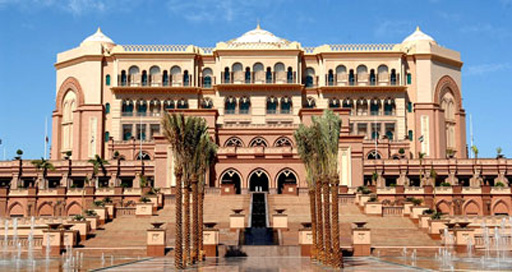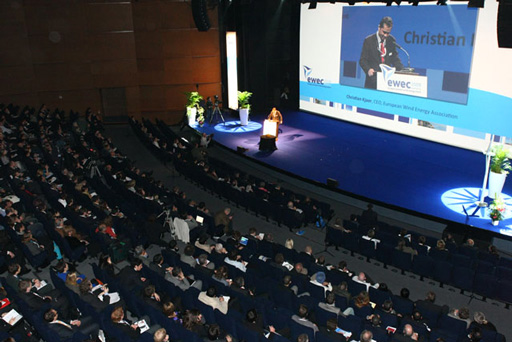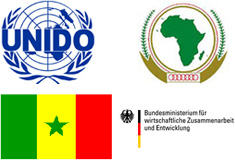Actualités
Athens Summit 2009, May 12-13 2009, Greece
 Sahara Wind at the Athens Summit 2009 - The Road to Copenhagen: Managing Climate Change & Energy Security in Southeast Europe and Beyond 12th–13th May 2009, Athens, Greece
Sahara Wind at the Athens Summit 2009 - The Road to Copenhagen: Managing Climate Change & Energy Security in Southeast Europe and Beyond 12th–13th May 2009, Athens, Greece
Hosted by FT Global Events in association with the Institute for Climate and Energy Security and C&C International Group of Companies, the summit brought together senior governmental officials, corporate leaders, financiers and experts to debate and discuss how the twin goals of energy security and managing climate change could be achieved to the benefit of all.
Sourcing and securing energy supplies and meeting climate change targets continue to be a top priority for policy makers around the world, despite the economic challenges.
Nomination for Prestigious World Technology Award April 28, 2009

Nomination for Prestigious World Technology Award
 April 28, 2009
April 28, 2009
The World Technology Award Honors individuals for their Innovative work with the Greatest Likely Long-Term Significance.The World Technology Network (WTN) announced that Khalid Benhamou of Sahara Wind Inc. has been selected as a nominee for a 2009 World Technology Award, presented by the World Technology Network, in association with TIME magazine, Fortune magazine, and Science magazine, among others. Khalid Benhamou is eligible to be selected as the Winner of the 2009 World Technology Award in the category of “Social Entrepreneurship.”
Rede von Bundeskanzlerin Angela Merkel / Grundsteinlegung für Hybridkraftwerk
Aus der Internet Seite: https://www.bundeskanzlerin.de
Rede von Bundeskanzlerin Angela Merkel anlässlich der Grundsteinlegung für das Hybridkraftwerk der ENERTRAG AG
Ich bin sehr gerne hierher gekommen – Katharina Reiche hatte mir schon vor geraumer Zeit von diesem Projekt berichtet. Ich bin natürlich auch hier, weil ich immer gerne in die Uckermark komme, und freue mich, wenn hier etwas Zukunftsweisendes passiert. Das ist mit dieser Grundsteinlegung heute der Fall. Ich bin auch sehr gerne hierher gekommen, weil Grundsteinlegungen und Investitionen in Zeiten, wie wir sie im Augenblick haben, Signale der Hoffnung, Signale der Zukunft sind.
Réunion de Suivi: Projet OTAN SfP-982620, 12-13 Février 2009, Al Akhawayn University Ifrane, Maroc
 Réunion de suivi du projet OTAN SfP-982620 réunissant les membres des quatre pays de l'OTAN (Etats-Unis, France, Allemagne, Turquie) associant le Maroc et la Mauritanie.
Réunion de suivi du projet OTAN SfP-982620 réunissant les membres des quatre pays de l'OTAN (Etats-Unis, France, Allemagne, Turquie) associant le Maroc et la Mauritanie.
Faisant partie des mécanismes de gestion des projets du Dialogue Méditerranéen de l'OTAN la réunion s'est tenue à l’Université Al Akhawayn d’Ifrane les 12-13 Février 2009. Cette première réunion de suivi du Projet OTAN Science for Peace SfP-982620 "Sahara Trade Winds to Hydrogen: Applied Research for Sustainable Energy Systems" entre dans le cadre des projets 'Science for Peace and Security' du Dialogue Méditerranéen de l'OTAN. La Société Sahara Wind Inc. est coordonnatrice de ce programme de recherche appliqué à échelle régionale. Celui-ci vise le co-développement de Nouvelles Technologies Energétiques au Maroc et en Mauritanie via des synergies industrielles.
Arabian Power and Water Summit, Abu Dhabi
 Arabian Power & Water Summit Emirates Palace Hotel, Abu Dhabi March 30 - 31 2009.
Arabian Power & Water Summit Emirates Palace Hotel, Abu Dhabi March 30 - 31 2009.
Presented during the Arabian Power & Water Summit panel discussion, the Sahara Wind project enabled participants to debate challenges and opportunities in the energy and renewables sector. The event gathered key industry players in the Persian Gulf region.
The Arabian Power & Water Summit was attended by over 400 senior level delegates and guests, with 58 industry-leading speakers, in 8 panel sessions, focusing on current relevant issues, including privatization, alternative energies and the sustainability of energy systems.
European Wind Energy Conference and Exhibition (EWEC 2009), France
 Sahara Wind at the European Wind Energy Conference and Exhibition (EWEC 2009) in Marseille, France on March 16 - 19 2009.
Sahara Wind at the European Wind Energy Conference and Exhibition (EWEC 2009) in Marseille, France on March 16 - 19 2009.
EWEC 2009 featured leading political figures, delivering their vision on the future of wind power from national, European and global perspectives. Visionary figures from the wind industry and finance sector discussed how harnessing wind energy on a large scale can address the compelling challenges of global warming and energy security. Focusing on grid integration, offshore, wind turbine technology and wind plant operation, the technology panel session at EWEC 2009 offered a variety of perspectives from all parts of the wind energy industry.
Union Pour la Méditerranée - Plan Solaire Méditerranéen
Le « Processus de Barcelone : Union Pour la Méditerranée » UPM , lancé le 13 juillet 2008 par le Président de la République Française et 43 Etats membres, a pour objectif de promouvoir une nouvelle politique de coopération et de développement dans toute la région méditerranéenne. Le Plan Solaire Méditerranéen représente le projet-phare de l'UPM. Les principaux objectifs du Plan Solaire Méditerranéen (PSM) sont le développement de capacités additionnelles de production d’électricité à partir d’énergies renouvelables (essentiellement d’origine solaire) dans les pays du Sud afin de satisfaire la demande locale en énergie. Le Plan prévoit également l’exportation d’une partie de l’électricité « verte » produite vers les pays de l’Union Européenne, étant donnée leur demande en énergies renouvelables et l’existence de mécanismes incitatifs mis en place dans le cadre de la proposition de directive européenne sur les énergies renouvelables. L'objectif concret de ce plan est la construction avant 2020 de 20 GW de capacités additionnelles de production d’électricité à partir d’énergies renouvelables.
Une conférence présentant les objectifs et modalités de fonctionnement du Plan Solaire Méditerranéen s'est tenue le 22 Novembre 2008 à Paris et a réuni des acteurs de haut niveau intéressés par une implication directe dans les projets du PSM : politiques, opérateurs privés et organisations industrielles, investisseurs potentiels (entreprises, fonds publics et privés), institutions financières, agences et organisations spécialisées. A ce titre, la Société de Développement Eolien Sahara Wind Inc. à eu l'occasion de participer à ces travaux visant à mettre en évidence ces potentialités dans un cadre de collaboration permettant à plus de 43 Etats membres de part et d'autre de la Méditerranée de répondre aux défis énergétiques et environnementaux du 21ème siècle.
Sahara Wind présenté au WREC à Glasgow, Royaume-Uni
Le projet Sahara Wind présenté au 10e Congrès mondial des énergies renouvelables du 21 au 24 juillet 2008
Cet événement fait suite congrès à Florence (2006), Denver (2004) et Cologne (2002). Le WREC a attiré un public véritablement international, avec plus de 100 pays participant au WREC 2006. Organisé tous les deux ans, cet événement majeur du calendrier les acteurs impliqués dans l'approvisionnement, la distribution, la consommation et le développement de sources d'énergie renouvelables. Les thèmes du Congrès sur les énergies renouvelables sont concentrés sur tous les aspects et domaines des énergies renouvelables, contribuant tout d'abord à ce qu'ils deviennent un contributeur majeur à un approvisionnement énergétique durable. La 10e Conférence mondiale sur les énergies renouvelables s'est tenue au Scottish Exhibition and Conference Centre, à Glasgow, au Royaume-Uni, du 20 au 25 juillet 2008.
7th World Wind Energy Conference 2008 (WWEC2008) June 24 - 26 in Kingston, Canada
The 7th World Wind Energy Conference 2008 (WWEC2008) builds on the World Wind Energy Conference tradition and presented scientific and technical advancements on all renewable energy (RE) technologies including wind, solar, biomass, hydro, hydrogen, and others.
WWEC2008 highlighted the role of community power in building a robust renewable energy industry and strategies to strengthen local project control and economic returns within the community. This event was organized by the Ontario Sustainable Energy Association, St. Lawrence College and the World Wind Energy Association, in partnership with the Government of Ontario. WWEC 2008 created a dynamic environment for renewable energy professionals, policy makers, government officials, manufacturers, engineers and community groups to come together to discuss a breadth of current topics related to all renewable energy generation technologies.
II International Forum on Hydrogen Technologies for the Developing World Moscow, Russia
 The Sahara Wind project presented during the Plenary session of the II International Forum Hydrogen Technologies for the Developing World in Moscow, Russia on 21-23 April 2008.
The Sahara Wind project presented during the Plenary session of the II International Forum Hydrogen Technologies for the Developing World in Moscow, Russia on 21-23 April 2008.
The International Partnership for the Hydrogen Economy 9th Steering committee was held on 21 April 2008, in conjunction with the II International Forum Hydrogen Technologies for the Developing World. The Forum was Organized by: Ministry of Education and Science (Russia), the Federal Agency of Science and Innovation (Russia) and the International Partnership for Hydrogen Economy (IPHE)
The Forum Objectives was:
§ To identify the role and place of hydrogen technologies in the future models of the world economy;
§ To discuss national strategies of hydrogen technology development and road maps for their deployment implemented by different countries;
§ To estimate prospects for use of hydrogen technologies by the developing countries, including possible contribution of the developing countries into establishment of the global hydrogen market;
§ To estimate prospects and define the most effective forms of cooperation with the developing countries in the field of hydrogen technologies.
Making renewable energy markets work for Africa - International Conference on Renewable Energies
Sahara Wind at the MAKING RENEWABLE ENERGY MARKETS WORK FOR AFRICA Policies, Industries and Finance for Scaling-Up conference April 16-18 2008 in Dakar, Senegal.
A joint activity of the African Union, the Government of Senegal, the German Ministry of Economic Cooperation and Development and the United Nations Industrial Development Organization.
Objectives
Making use of lessons learnt and experience gained with renewable energy projects in Africa and elsewhere, the conference examined how bottlenecks to renewable energy market related to policies, technologies, financing and capacity can be addressed so as to increase energy challenges in Africa. The conference brought together high-level decision makers to provide visible leadership and commitment to a common strategy for market-based scaling up of renewable energies that is informed by lessons learnt from concrete case studies and the energy situation in Africa.
12ème session de la conférence générale de l'ONUDI
 Le projet Sahara Wind presenté lors de la 12ème session de la conférence générale de l'ONUDI le 6 Décembre 2007
Le projet Sahara Wind presenté lors de la 12ème session de la conférence générale de l'ONUDI le 6 Décembre 2007
Les États membres se réunissent tous les deux ans à la Conférence générale, l'organe législatif supérieur de l'Organisation des Nations Unies pour le développement industriel ONUDI. Celle-ci approuve le budget, le programme de travail et fournit des orientations sur des questions de fond essentielles.
La douzième session de la Conférence générale de l’ONUDI s’est tenue du 3 au 7 décembre 2007 à Vienne sur le thème général «Le développement industriel dans un paysage mondial en mutation». La Conférence a réuni environ 1 000 participants, dont des chefs d'État et de gouvernement, des ministres et d'autres hauts fonctionnaires, ainsi que de hauts représentants d'autres organismes des Nations Unies. Un forum de haut niveau sur les trois priorités thématiques de l’ONUDI: réduction de la pauvreté, renforcement des capacités commerciales, énergie et environnement a constitué un élément important.






